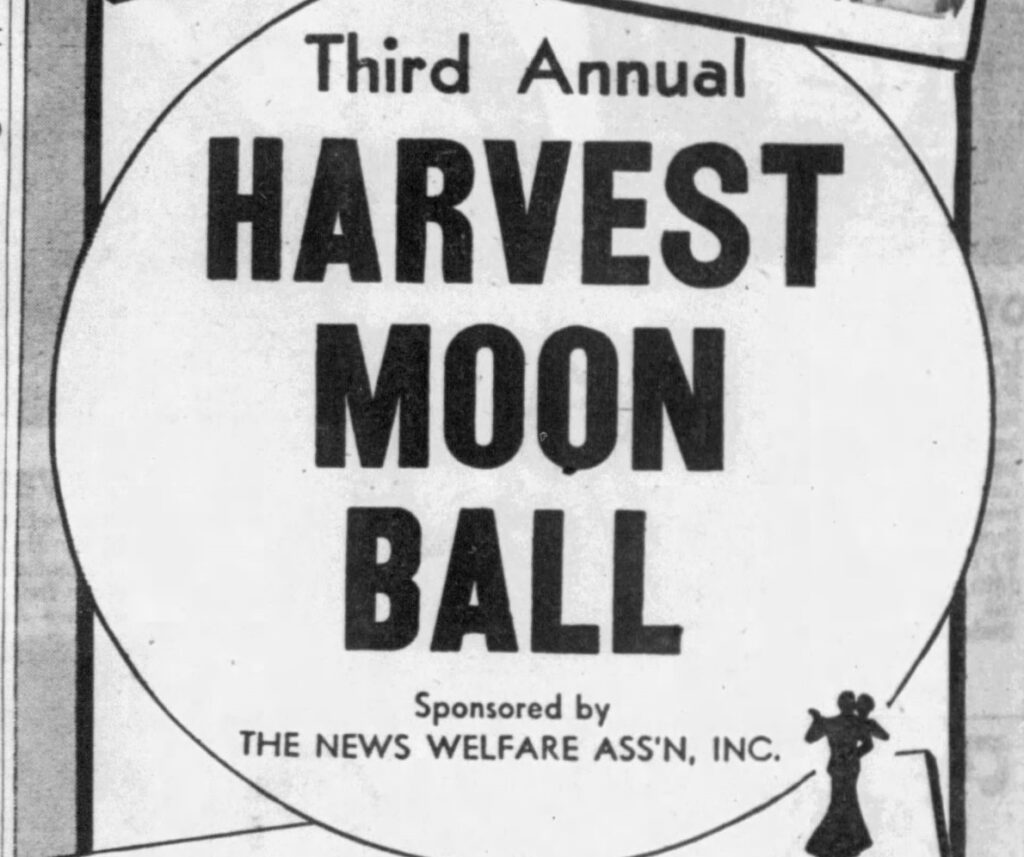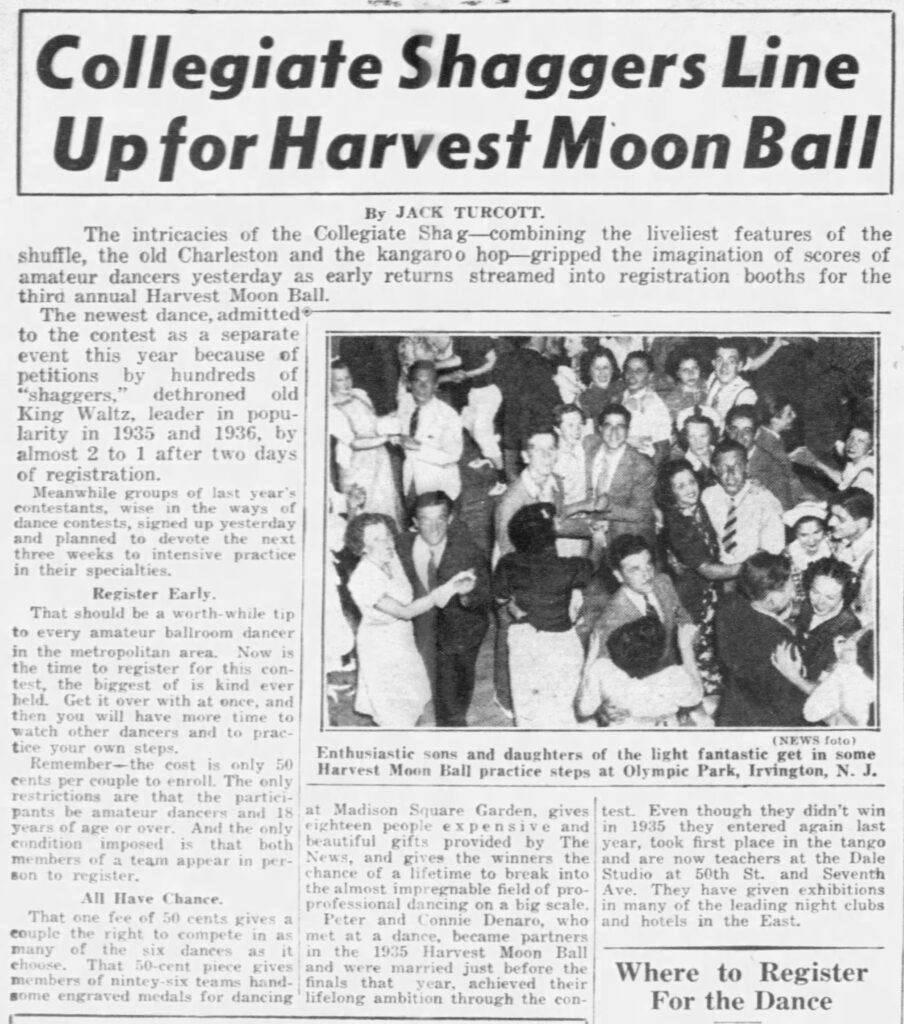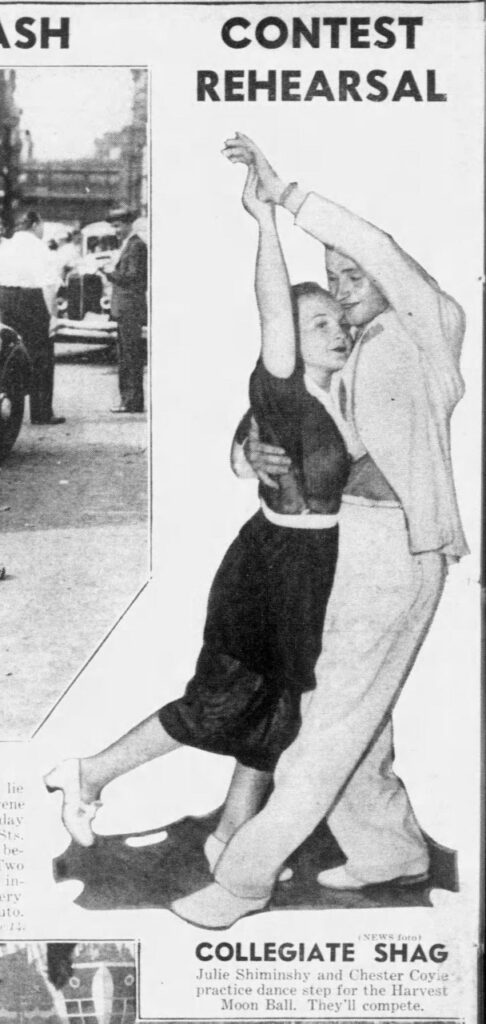This is just a short quote from a Bobby White’s article about The 1937 Harvest Moon Ball which includes some thorough insights on Collegiate Shag roots and history. See the original version on his blog SWUNGOVER. We are sharing it here with Bobby’s personal permission so it would be more accessible to wider audience.
To support Bobby White’s insights and research on jazz dance history, please consider a suggested donation of 6$ to read a full article.
The 1937 Harvest Moon Ball – The “New” Kid
Most of this article will focus on the Lindy Hop of the 1937 Harvest Moon Ball. However, we want to first discuss something important that happened in this year’s ball. In that announcement mentioned above, a new dance appeared in the listing of the divisions: “Collegiate Shag.” Those who read SWUNGOVER’S 1936 HMB article will remember a Collegiate Shag couple had actually made it into the Lindy Hop finals, only to find themselves surrounded by Whitey’s Lindy Hoppers. (No pressure.)
Well, the next year, according to the Daily News, the “Collegiate Shag” was demanded by hundreds of the newly crazed, mostly-student dancers — and when they signed up for the division, they doubled the amount of the applications of the next most popular dance, the Waltz.
Everyone knows Lindy Hop was a product of the Black American culture of Jazz-era Harlem, New York. But what about this newcomer to New York, Shag? Where did it come from? And what are its cultural roots? Before we get the help of some Shag experts to help answer that, try this thought exercise: Imagine for a moment we simply said “You might not know this, but Shag was a ‘White dance.’” How would that make you feel about the dance? What would that mean to you? Would it make you feel uneasy, or perhaps the opposite — more comfortable with its existence? (For instance, a White Shag dancer being convinced it’s a “White dance” might feel comfort in knowing they perhaps don’t have to worry about navigating appropriation as much as a Lindy Hopper might.)
Now, imagine we said, “You might not know this, but Shag was originally a ‘Black dance.’” Now, how would that make you feel, and what would that mean to you? Did you all of a sudden find Shag “cooler” after that sentence, if you didn’t think it was cool before? Did it make you uncomfortable, knowing there was perhaps more of the problem of appropriation to consider than you had already thought?
And how did you feel that those questions imply a dichotomy — that “White swing dance” and “Black swing dance” are two valid categories in terms of looking at this specific situation?
We’d like to argue that thinking of jazz era partnership dances as “White dances” verses “Black dances” is not a very realistic, or useful, way to view them. First off, we will do so by arguing there’s no such thing as a jazz era dance that doesn’t in some way share ownership with Black American artistic values.
Let’s begin with the music. “Collegiate Shag” as this dance is done today was evolved to jazz and swing music in the jazz era. What are some of the values emphasized in Black American Jazz music? Swung rhythm, improvisation, call and response, individuality interconnected with teamwork, sharing and collaboration between musicians and dancers, and sharing and shining among fellow musicians (such as found in solo trading, cutting contests, and jams). Now then, if a dance done to this music embodies and emphasizes those Black American artistic values, then those values are in its DNA. Even if White people predominantly developed them, they were doing so because they correctly interpreted those Black values in the music. In this sense, any swing dance that emphasizes those same values is tied to Black American dancing values on a fundamental level. Does Shag embody these?
Well, let’s look at the dancing values that Shag commonly shows that are often emphasized in Black American culture, and that were not commonly emphasized in early 1900s European-American dancing culture: constant improvisation, solo dancing expression even within partnership dances, full-bodied dancing (all body parts available for expression), breaking away (partnering without physical contact), emphasis on rhythmic complexity, sharing and shining the dance, and a showcasing of many different personalities within its movement — such as humorous, elegant, fierce, or eccentric movement.
(Please note, we’re not saying European-American partner dancing is completely devoid of all of those traits, just that they are just not as emphasized, or in the same characteristic ways.) So, again, even if it were developed by White Americans from its very beginning, it still has all the hallmarks of a strong influence from Black American dancing values. (We would make a similar argument for there being Black American cultural values inherent in the Southern California dances, Balboa and “swing.”)
Okay, but, what about this “Collegiate Shag” the Harvest Moon Ball is showcasing, what are it’s literal origins? Where did it come from? Shag historians have differing points of view. Some think it most likely comes from vaudeville steps which have Black origins, others think it evolves from a dance named “Shag” commonly mentioned in papers from the Carolinas, which also probably had some roots in Black American dance forms and movement paired together with White American dances. (Whenever dancing from the South is concerned, there’s a pretty good bet Black American values are a part of it, as Black culture has always greatly influenced Southern culture. We will see this happen even more definitively by the creation of the Big Apple later this year.)
As far as the Harvest Moon Balls go, its professed “expert” on Lindy Hop and Collegiate Shag was a man named Bernie Sager. Bernie was a very well-known and influential dance instructor at the time. And he had demonstrated the “Collegiate Shag” for the “dancing masters annual convention” in August of 1937, as “the very latest step in ball room fox trot dancing.” By 1939, he’s being credited with having introduced the dance to Northern ballrooms, perhaps implying by that wording that it came from southern dance forms. And, by 1940, he is mentioned as having personally re-styled a dance step called the flea hop into the “Collegiate Shag” himself.
[continue on SWUNGOVER]
To support Bobby White’s insights and research on jazz dance history, please consider a suggested donation of 6$ to read a full version of this article on his website.



